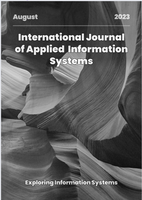The week's pick
Reseach Article
Efficient Mining of FP-Growth Algorithm Structure and Apriori Algorithm using OFIM for Big Data
| International Journal of Applied Information Systems |
| Foundation of Computer Science (FCS), NY, USA |
| Volume 12 - Number 47 |
| Year of Publication: 2025 |
| Authors: Abdulkader M. Al-Badani, Abeer A. Shujaaddeen, Motea M. Aljafare |
 10.5120/ijais2025452013
10.5120/ijais2025452013
|
Abdulkader M. Al-Badani, Abeer A. Shujaaddeen, Motea M. Aljafare . Efficient Mining of FP-Growth Algorithm Structure and Apriori Algorithm using OFIM for Big Data. International Journal of Applied Information Systems. 12, 47 ( Mar 2025), 8-15. DOI=10.5120/ijais2025452013
Abstract
Mining big data is difficult.Working with massive datasets requires the use of computer software and an efficient algorithm to solve problems.Data mining specialists are familiar with two popular association rule algorithms: apriori and fp-growth. Businesses are able to make well-informed decisions based on customer trends and behavior thanks to these algorithms' assistance in finding patterns and correlations within large datasets. These data mining procedures are now even more accurate and efficient thanks to developments in machine learning techniques. However, there are some disadvantages to the association rule approach, including the requirement for a lot of memory, the necessity for extensive dataset searches to ascertain the item set's frequency, and sometimes less-than-ideal rules. The authors of this study examined the fp-growth, Apriori, and OFIM algorithms in order to analyze the rule results of the three methods. Significant performance differences were found in the results, with the fp-growth algorithm showing the best efficiency when working with big datasets. On the other hand, the Apriori approach had scalability issues and frequently resulted in longer processing times as the amount of the dataset expanded, despite being simpler to construct.Changes to the FP_Growth algorithm's operation are proposed in this study.The suggested method would reduce mining time and the quantity of regularly created items by using the suggested matrix OFIM to construct a highly compact FP-tree, which would significantly lessen the amount of decision-making required for huge datasets.Furthermore, by minimizing the number of items generated often, our method optimizes memory usage and greatly increases its speed while processing huge datasets.
References
- Tamba, S. P., Sitanggang, M., Situmorang, B. C., Panjaitan, G. L., & Nababan, M. (2022). Application of Data Mining To Determine the Level of Fish Sales in Pt. Trans Retail With Fp-Growth Method. INFOKUM, 10(02), 905-913.
- Dunham M, Naughton J, Chen W D, et al. 2010..Proceedings of the 2000 ACM SIGMOD international conference on Management of data[J]. Water International, 26(4),pp. 607-609.
- Singh R, Bhala A, Salunkhe J, et al.2015. Optimized Apriori Algorithm Using Matrix Data Structure[J]. International Journal of Research in Engineering and AppSciences,9(5),pp. 2249-3905.
- Yu, C., Liang, Y., & Zhang, X. 2023. Research on Apriori algorithm based on compression processing and hash table. In Third International Conference on Machine Learning and Computer Application (ICMLCA 2022) (Vol. 12636, pp. 606-611). SPIE.
- A. S. Hoong Lee, L. S. Yap, H. N. Chua, Y. C. Low, and M. A. Ismail. 2021. “A data mining approach to analyse crash injury severity level,” J. Eng. Sci. Technol., vol. 16, pp. 1–14.
- S. Wang, J. Cao, and P. S. Yu. 2019 . “Deep learning for spatiotemporal data mining: A survey,” IEEE Transactions on Knowledge and Data Engineering, vol. 34, no. 8, pp. 1–21.
- Elisa, E. 2018. Market Basket Analysis Pada Mini Market Ayu Dengan Algoritma Apriori. Jurnal RESTI (Rekayasa Sistem dan Teknologi Informasi), 2(2),pp. 472-478.
- Salam, A., Zeniarja, J., Wicaksono, W., & Kharisma, L. 2018. Pencarian Pola Asosiasi Untuk Penataan Barang Dengan Menggunakan Perbandingan Algoritma Apriori Dan Fp-Growth (Study Kasus Distro Epo Store Pemalang). Dinamik, 23(2),pp. 57-65.
- M. D. Febrianto and A. Supriyanto. , 2022. “Implementasi algoritma apriori untuk menentukan pola pembelian produk,” Jurikom, vol. 9, no. 6, pp. 2010–2020.
- M. M. Hasan and S. Z. Mishu..2018. “An adaptive method for mining frequent itemsets based on apriori and fp growth algorithm,” in 2018 International Conference on Computer, Communication, Chemical, Material and Electronic Engineering (IC4ME2). IEEE, pp. 1–4.
- A. Almira, S. Suendri, and A. Ikhwan, 2021.“Implementasi data mining menggunakan algoritma fp-growth pada analisis pola pencurian daya listrik,” Jurnal Informatika Universitas Pamulang, pp. 442–448.
- J. Han, J. Pei, and Y. Yin. .2000. “Mining frequent patterns without candidate generation,” ACM sigmod record, no. 2, pp. 1– 12.
- F. Wei and L. Xiang. 2015. “Improved frequent pattern mining algorithm based on fp-tree,” in Proceedings of The Fourth International Conference on Information Science and Cloud Computing (ISCC2015), pp. 18–19.
- R. Krupali, D. Garg, and K. Kotecha. 2017. “An improved approach of fp-growth tree for frequent itemset mining using partition projection and parallel projection techniques,” International Recent and Innovation Trends in Computing and Communication, pp. 929–934.
- AGRAWAL, Rakesh, et al. 1994. Fast algorithms for mining association rules. In: Proc. 20th int. conf. very large data bases, VLDB. pp. 487-499.
- HAN, Jiawei; PEI, Jian; YIN, Yiwen. 2000. Mining frequent patterns without candidate generation. ACM sigmod record, 29.2: 1-12.
- SHRIDHAR, M.; PARMAR. 2017. Mahesh. Survey on association rule mining and its approaches. Int J Comput Sci Eng, 5.3: 129-135.
- KHANALI, Hoda; VAZIRI, Babak. 2017. A survey on improved algorithms for mining association rules. Int. J. Comput. A,pp. 165: 8887.
- Patil, R. Rana, and P. Singh.2022. “Distributed frequent pattern analysis in big data.”International Research Journal of Modernization in Engineering Technology and Science ,pp.1-3.
- Huaman Llanos, A. A., Huatangari, L. Q., Yalta Meza, J. R., Monteza, A. H., Adrianzen Guerrero, O. D., & Rodriguez Estacio, J. S. 2024. Toward Enhanced Customer Transaction Insights: An Apriori Algorithm-based Analysis of Sales Patterns at University Industrial Corporation. International Journal of Advanced Computer Science & Applications, 15(2).
- BALA, Alhassan, et al. 2016. Performance analysis of apriori and fp-growth algorithms (association rule mining). Int. J. Computer Technology &Applications, 7.2,pp. 279-293.
- Gruca, A. 2014. Improvement of FP-Growth algorithm for mining description-oriented rules. In Man-Machine Interactions, Part of Advances in Intelligent Systems and Computing, (AISC), Springer, vol. 242, pp. 183-192.
- Sohrabi, M. K., and Marzooni, H. H. 2016. Association rule mining using new FP-Linked list algorithm. Journal of Advances in Computer Research (JACR), 7(1), pp. 23-34.
- Sagar, B. P., and Kale, S. 2017. Efficient algorithms to find frequent itemsets using data mining. International Research Journal of Engineering and Technology ( IRJET), 4(6), pp. 2645- 2648.
- Hao, J., and Xu, H. 2017. An improved algorithm for frequent itemsets mining. In 5th International Conference on Advanced Cloud and Big Data (CBD), IEEE Computer Society , pp. 314-317.
- Princy. S, Ankita, H., Babita, P., and Shiv, K. 2017. A survey on FP (Growth) tree using association rule mining. International Research Journal of Engineering and Technology( IRJET), vol. 4, Issue 7, pp. 1637-1640.
- B. Zhang. 2021 .“Optimization of fp-growth algorithm based on cloud computing and computer big data,” International Journal of System Assurance Engineering and Management, pp. 853–863.
- S. X. Le Zhang, X. Li, X. Wu, and P.-C. Chang. 2019. “An improved fp-growth algorithm based on projection database mining in big data,” Journal of Information Hiding and Multimedia Signal Processing, pp. 81–90.
- GU, Juan; JIANG, Tianyuan; SHEN, Lei. 2023.Equipment maintenance data mining based on FP-growth algorithm. In: International Conference on Electronic Information Engineering and Data Processing (EIEDP 2023). SPIE,. pp. 216-222.
- Blake, C. L., and Merz., M. J, UCI Repository of Machine Learning Databases [http://www. ics. uci. edu/~ mlearn/ MLRepository. html]. Irvine, CA: University of California‖, Department of Information and Computer Science.
Index Terms
Keywords

